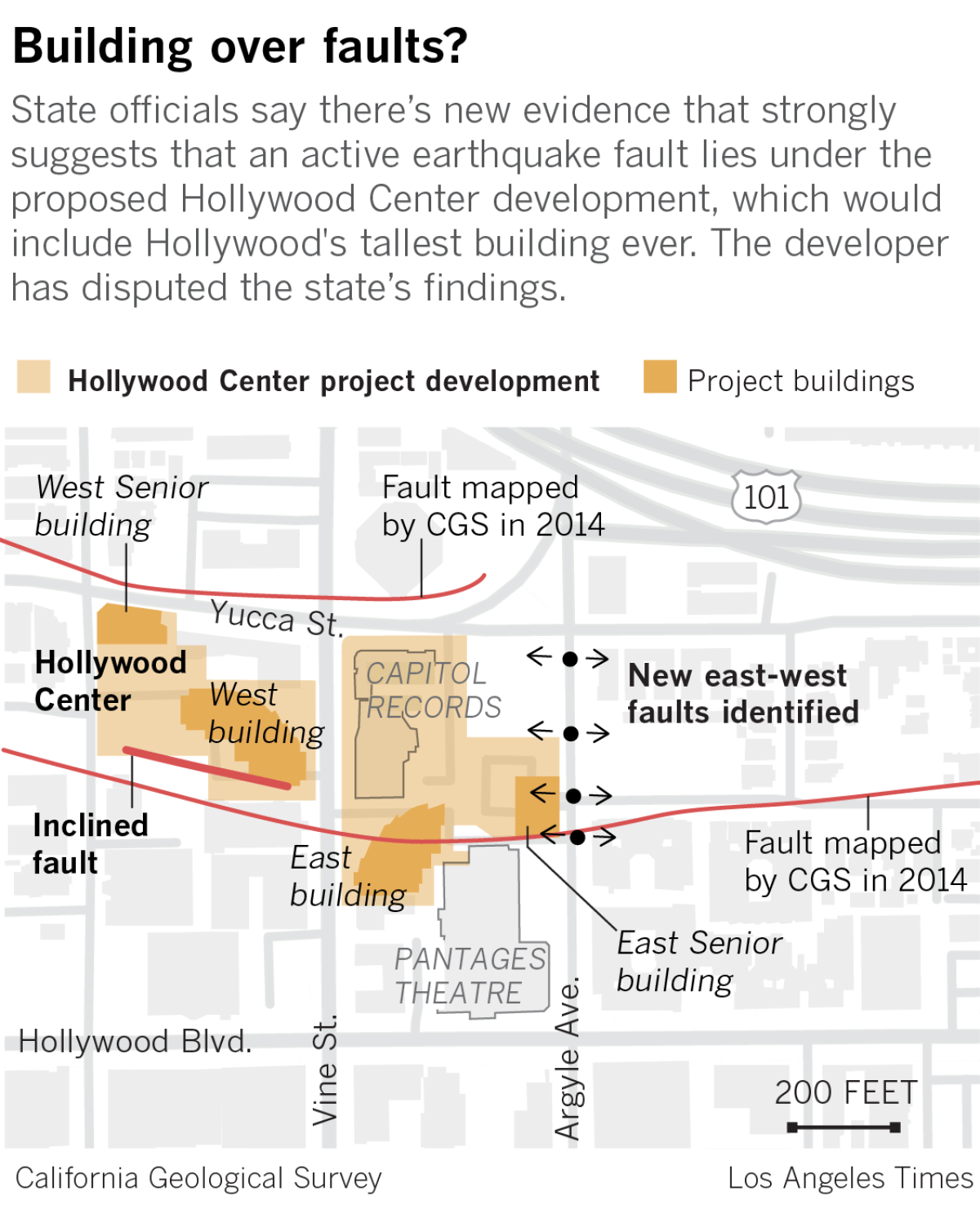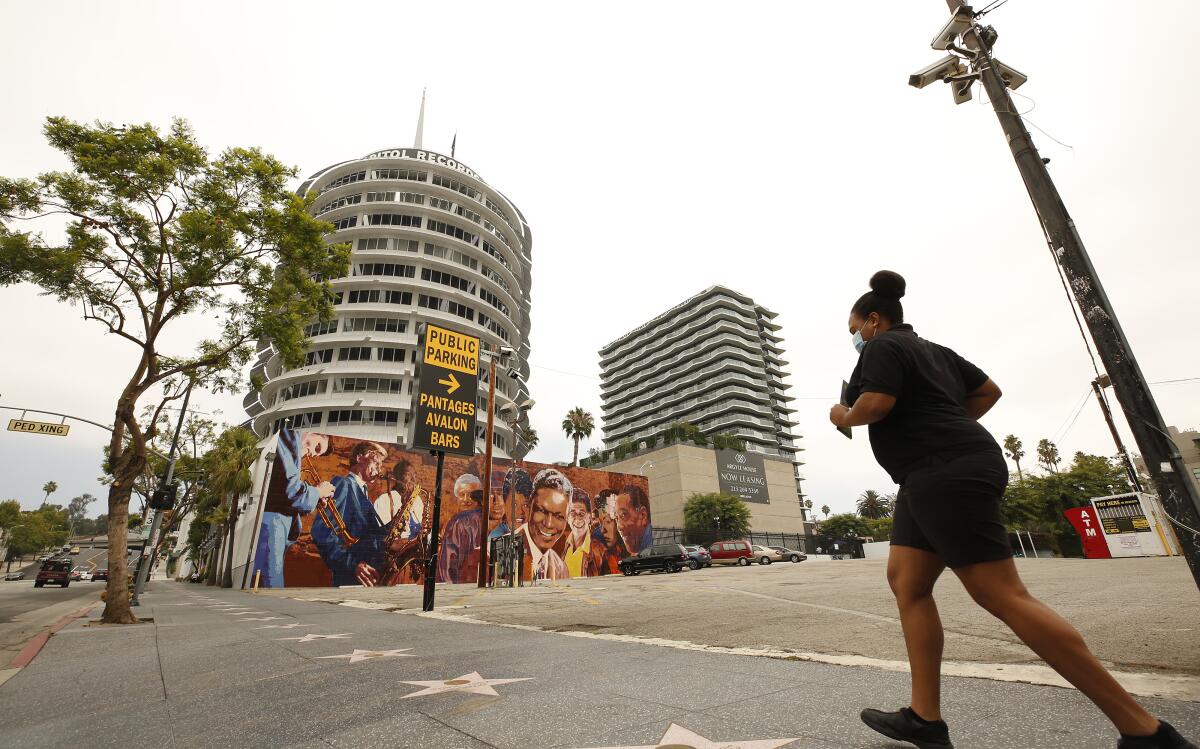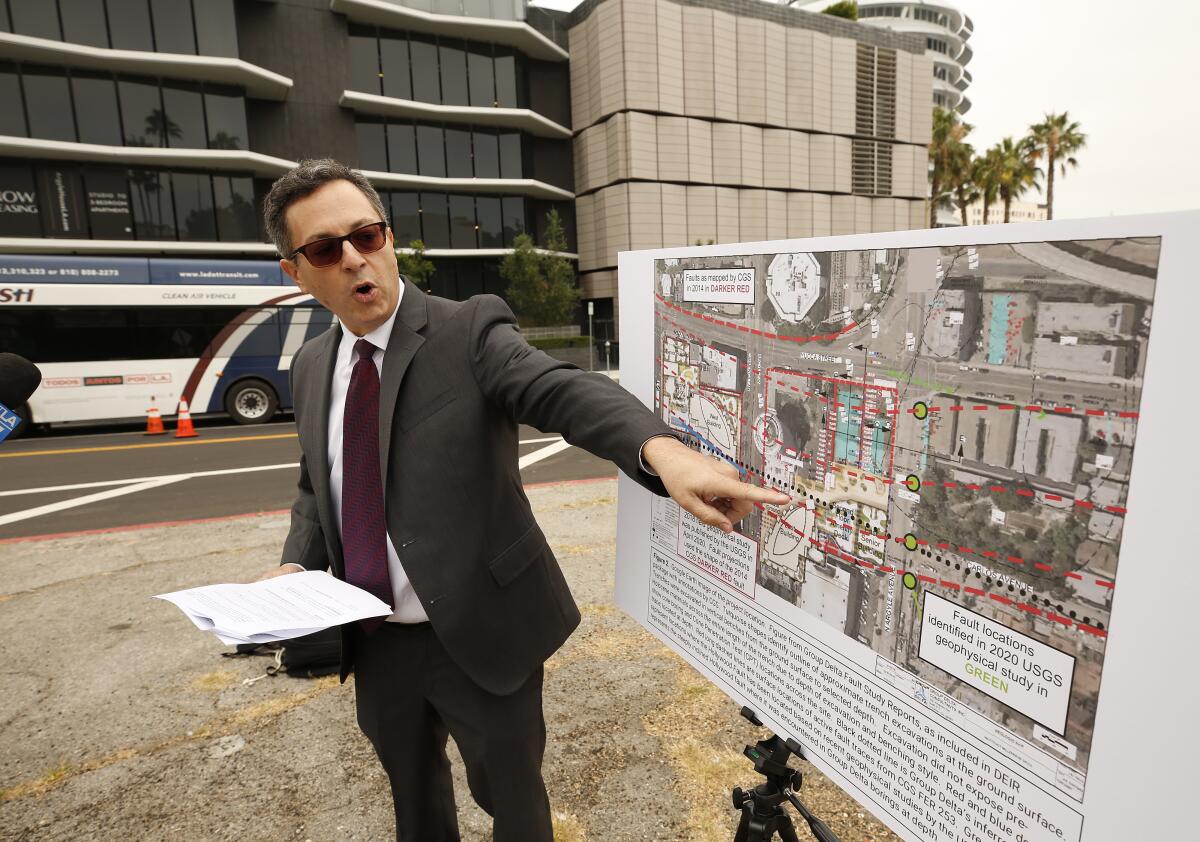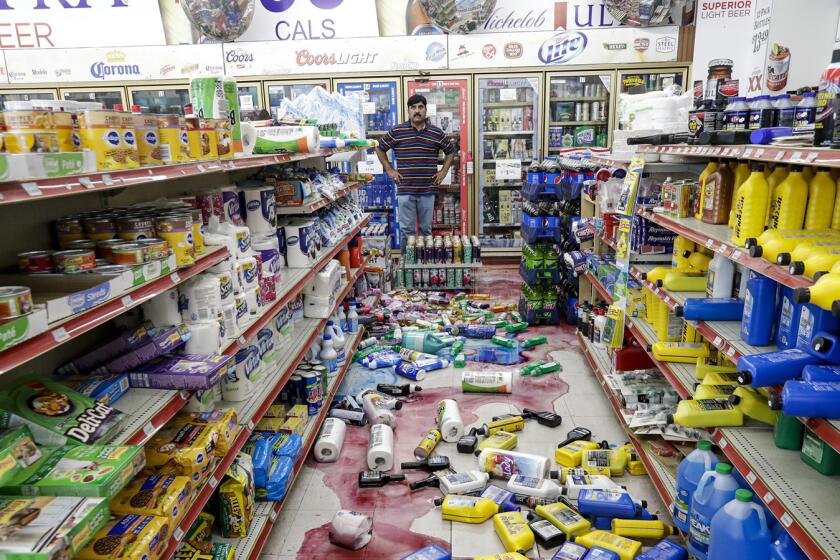Strong evidence quake faults run through site of Hollywood skyscrapers, state says
- Share via
State geologists have concluded there is strong evidence that multiple earthquake faults run through the site of a controversial skyscraper development proposed for Hollywood, records obtained by The Times show.
A letter from the California Geological Survey to Los Angeles city planners, obtained through a public records act request, raises new questions about the Hollywood Center development. The project calls for 46- and 35-story skyscrapers that flank the famed Capitol Records Tower, along with two buildings for low-income senior residents that would each stand 11 stories tall.
“These studies strongly support the presence of an active ... fault strand entering the eastern Hollywood Center property,” the letter said. “Importantly, the combined data indicate that more than one ... fault trace of the Hollywood Fault crosses the proposed project site.”
The state also noted a recent U.S. Geological Survey report that found four parallel sections of the Hollywood fault identified just east of the property which are believed to extend under the development.
For years, state scientists have said there’s evidence an earthquake fault slices through a strip of Hollywood. In 2014, state officials mapped out the Hollywood fault — capable of a magnitude 7 earthquake — shown running through the area.
But that hasn’t stopped a New York-based developer and Los Angeles city officials from championing a $1-billion plan that would create Hollywood’s tallest and largest development.

Philip Aarons, a founder of Millennium Partners, this week disputed the state’s conclusions, as he has in the past.
“It is clear that the data relied upon by the state is significantly inferior in quality to the data acquired from the extensive trenching done on our site,” Aarons said in a statement. “We will continue to work diligently with the city to review any and all data with the goal of assuring the construction of the most seismically safe structure in the history of Los Angeles.”
Aarons said a new geology report was prepared for the draft environmental impact report, which was published earlier this year. It again concludes there have been no earthquake faults on the property that have moved since the last Ice Age, “and therefore, the site is safe to build on, according to state and city requirements.”

Aarons said the Hollywood Center project site “has been the subject of the most extensive geotechnical testing of any property in Hollywood. From 2012 to 2019, seven fault investigations were performed. In each and every case, those studies have come to the conclusion that there is no active fault on the project site.”
The California Geological Survey said there were limitations in the previous studies cited by the developer as evidence of the absence of a fault. For instance, the state agency said a fault trench excavated in 2014 was not dug long enough for the developer to disprove the state’s previous conclusion that an active earthquake fault ran underneath the property.
Seismologist Lucy Jones said the California Geological Survey is the gold-standard scientific authority for recognizing the locations of faults in California.
“That’s their job,” said Jones, a former chair of the California Seismic Safety Commission and former science advisor for seismic safety for Los Angeles Mayor Eric Garcetti. “And they say the studies they have strongly support the presence of an active fault strand in the property.”
The mayor’s office did not comment publicly on the state’s letter.
California has suffered some destructive earthquakes in the last few decades but much bigger quakes are possible. These maps show some scenarios.
Formerly known as Millennium Hollywood, the Hollywood Center project would place nearly 1.3 million square feet of developed space on about 4½ acres of land, adding more than 1,000 residential housing units and more than 30,000 square feet of retail and restaurant space. An alternate plan would involve creating more than 880 housing units and a 220-room hotel.
California law generally prohibits the construction of buildings directly atop earthquake faults. A building risks catastrophic collapse if it sits on land that splits apart during an earthquake, in which one side of the fault lurches past the other.
In the magnitude 6.6 Sylmar earthquake of 1971, 80% of buildings on land where the fault ruptured the surface suffered moderate to severe damage, while only 30% of buildings constructed a little farther away suffered such damage.

The existing map of the Hollywood fault drawn by state officials in 2014 already places the path of the Hollywood fault under the proposed 46-story East Building and under or very near the 11-story east senior residence building.
In 2015, however, the Los Angeles Department of Building and Safety, then led by Raymond Chan, rejected the state’s conclusion and sided with the developer’s geologist. City officials agreed that an earthquake fault was probably located deep beneath the property but that it was too old to be considered active.
Still, the development was halted by a Los Angeles County Superior Court judge in 2015, who ruled that the project’s description listed in its environmental impact report was too vague to permit a reasonable and meaningful review. The ruling tossed out the city’s previous approval for the project. The judge’s ruling was upheld by a state appeals court last year.
New odds mean a large quake on the Garlock fault is much more likely and the chance of a large quake on the San Andreas has also increased.
Since 2014, there have been a number of scientific advances made by federal and state scientists in mapping earthquake faults.
In May, the U.S. Geological Survey and California Geological Survey released a 48-page report detailing the latest science of where the Hollywood fault sits, based on a new fault-finding technique called guided wave. It’s a technique in which scientists can shoot a sound wave down a suspected surface of the fault, and instruments can verify whether it is indeed a fault.
The technique has proved to be very accurate in identifying the location of faults where they meet the surface, said former state geologist John Parrish.
In the case of the Hollywood Center, test results not only verified the earthquake fault the state mapped as going through the property in 2014, but identified three new, additional and parallel fault strands — all just east of the proposed development, said Parrish, who was chief of the California Geological Survey at the time the study was done.
“Those will go all the way through” and continue west into the Hollywood Center project parcel, Parrish said. “They just didn’t run up to the curb and stop. Unfortunately, they’re going to go through that piece of property.”
The proposed 35-story west building also has a nearby fault. Because of the way it is angled into the ground at the surface, it’s possible the tower’s foundation could be built astride two sides of the fault, Parrish said. In such a scenario, the foundation could suddenly snap as one side of the fault moves past the other in a major quake, setting the stage for a catastrophic collapse.
The new data also suggest a fault line runs beneath a luxury apartment complex built at the site of the former KFWB-AM radio studios, at 6230 Yucca St., which is also known as 1755 Argyle Ave., Parrish said.
The site, just east of the Capitol Records Tower, is home to an 18-story complex called the Argyle House, developed by the Related Cos. and opened in 2018.

In 2014, state officials removed from a map a fault line that was suggested to run under the former KFWB studios after tests showed the fault was inactive. But Parrish said evidence uncovered recently identifies how a fault near the Hollywood courthouse — about two-fifths of a mile to the east of the Argyle House — is active.
“If it’s active in one area on a fault, the whole fault is considered active,” said Parrish, who led the California Geological Survey from 2005 to 2018. “It is unlikely that this string of faults — the Raymond, Hollywood and Santa Monica, which have all been shown to be active for a 110-mile-long stretch — that the ... acres that they want to build a Millennium property on is not active.”
In a statement, the Related Cos. disputed the recent government studies as “not as accurate at finding if a fault is active, and therefore, are not the recommended method for determining the activity of faults.”
Parrish said the California Geological Survey has traditionally contacted local governments to alert them if a large development may be sitting on geologically unstable land.
“It’s for the public health, public health and safety. The public’s already paid for it, so they might as well have access to it,” Parrish said. “We don’t have a stake in whether it’s built or not, but we certainly want the decision to be made [by leaders] fully aware of what geologic hazards might be for the area.”
The California Geological Survey declined interview requests.
Researchers say an earthquake fault along the L.A. coast long believed dormant is in fact active and could generate a devastating quake.
One California project that didn’t receive the attention of the state agency before it was built was also developed by Millennium Partners: the 58-story Millennium Tower in San Francisco, a $350-million luxury residential project that opened in 2009 but has since started to lean and sink. It will require a costly retrofit to upgrade the foundation — which originally stretched only to a layer of sand, just above a layer of clay — and extend it to bedrock.
“They built it on liquefiable lands ... but they never called us,” Parrish said. “So we didn’t comment.”
The residents of Millennium Tower have blamed Millennium Partners for the design problems; the developer, in turn, blamed a neighboring construction project for sucking water out of the soil beneath the tower, causing the noticeable sinking.
Millennium Partners’ experience with the leaning skyscraper is more reason to be skeptical of the developer’s claims, said Robert P. Silverstein, a Pasadena lawyer who represents neighborhood groups opposed to the development who successfully sued to halt the previous version of the Hollywood project.
Silverstein also expressed a lack of confidence in how the city has handled the project in the past, noting that key officials who championed the development have since been embroiled in corruption investigations.
“These independent governmental studies are bombshells that prove the Millennium skyscrapers cannot be allowed,” Silverstein said.
The city is currently working on a final version of the Hollywood Center’s environmental impact report. Following its completion, the project will face public hearings before the City Council, the planning commission and the council’s planning and land use management committee.
More to Read
Sign up for Essential California
The most important California stories and recommendations in your inbox every morning.
You may occasionally receive promotional content from the Los Angeles Times.














